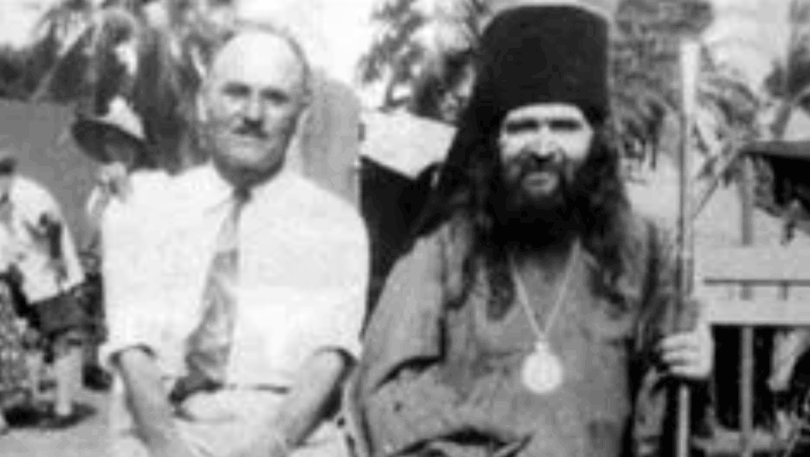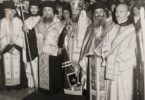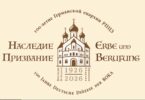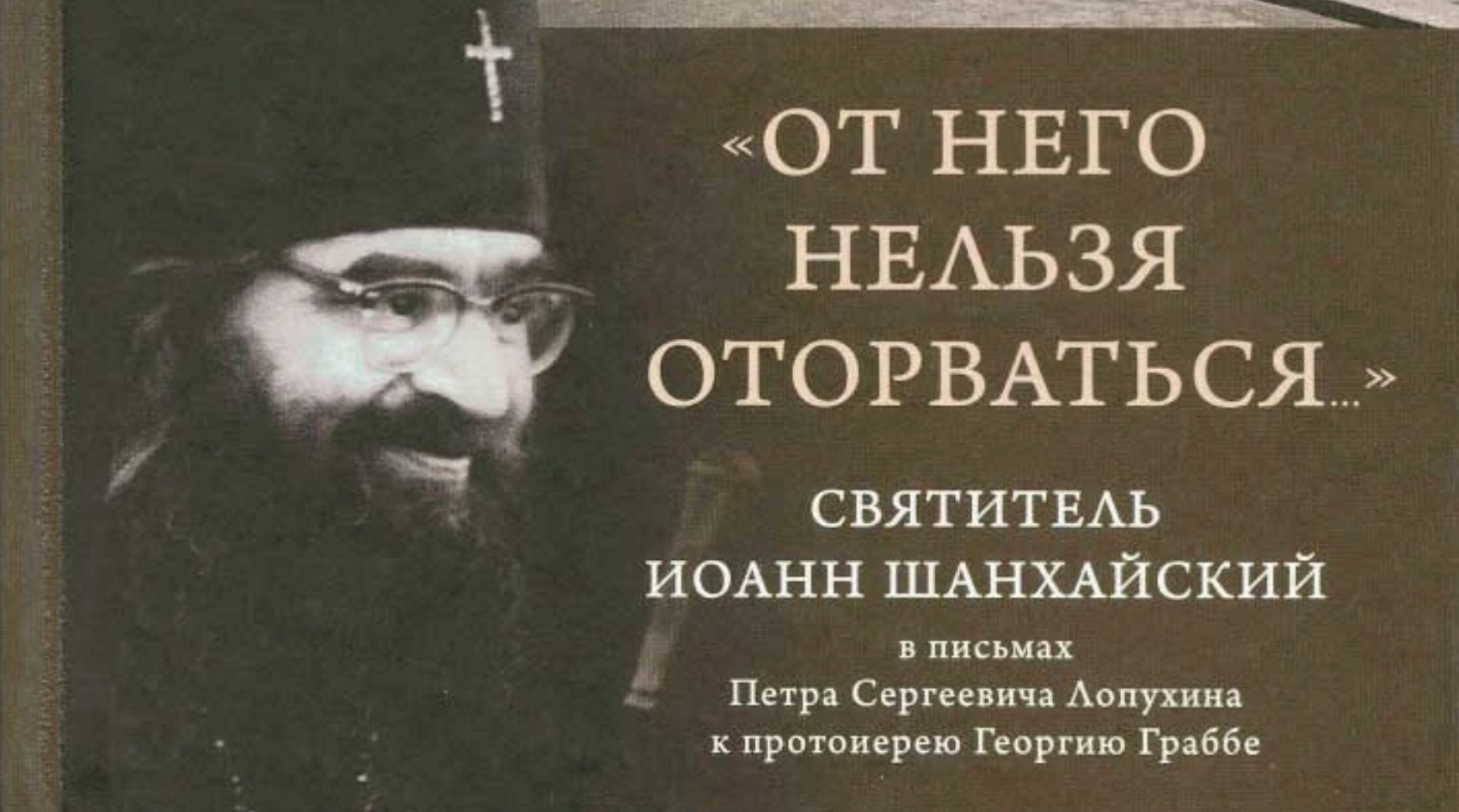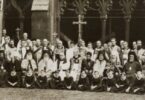Exile from Shanghai to Tubabao
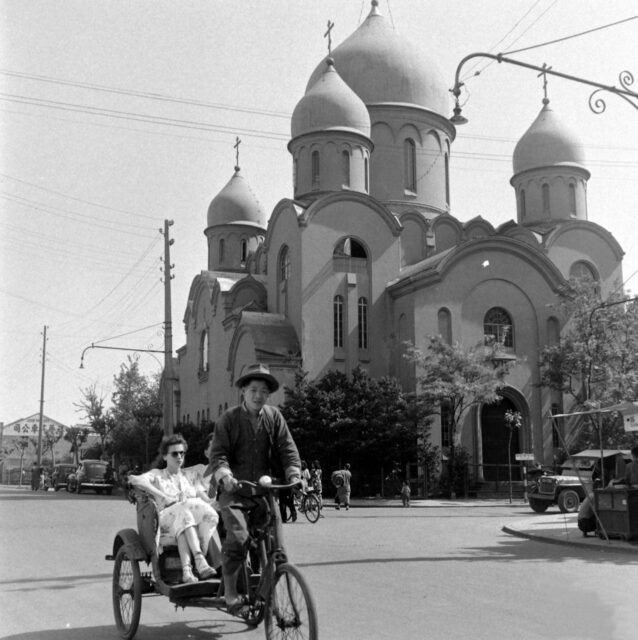
St. John’s Cathedral in Shanghai, dedicated to the icon of the Mother of God “Joy of All Who Sorrow,” 1948
As Shanghai was falling due to the civil war between communist forces and Chinese nationalists, by the end of 1948 the White Russians, [1] ‘White Russians’ refers to people who fought against the ‘Reds’ in the Soviet Union after the Bolshevik Revolution. for whom China had been home since the 1920’s, were looking for ways to escape. With Shanghai itself under threat from the communists, the International Refugee Organization (IRO) [2]IRO was a United Nations agency focused on addressing the refugee crisis following World War II. Its main functions included administering camps for displaced persons, helping them resettle, and … Continue reading was persuaded, partly as a result of intensive lobbying by the Russian Emigrants’ Association of Shanghai, that evacuation should be undertaken without delay. The IRO came up with the island of Tubabao in the Philippines as a temporary holding place for Russian refugees from Shanghai, who duly began to arrive there in the first five months of 1949. [3]Fitzpatrick, Sheila. 2019. “Russians in the Jungle: Tubabao as a Way Station for Refugees from China to Australia, 1949.” History Australia 16 (4): 695–713. Russians in the jungle: Tubabao as a … Continue reading At that time, the Philippines was under the administration of President Elpidio Quirino, who undertook to accept 6,000 Russians for a maximum of four months while the IRO would negotiate their permanent resettlement elsewhere. [4] Fitzpatrick (2019). 698. The exodus was quite understandably rushed and chaotic in nature. The first ship left Shanghai on January 14, 1949. Archbishop John came to the Shanghai harbor and served a safe voyage moleben for the ship’s passengers, after which he blessed each one of them on their journey. [5] Dunlop, John B. 2017. Exodus: St John Maximovitch Leads His Flock out of Shanghai. (2017, SVS Press). 145.
Life on Tubabao
Of course, the numbers of exile Russian population on the island of Tubabao fluctuated due to resettlement departures, and individual late arrivals. Regarding the ethnic and social make-up of the camp, N. V. Moravskii observed: [6] Nikolai Moravskii was born in Shanghai in 1923 into a family of Russian émigrés. In 1949 he was evacuated to the Philippines.
The overwhelming majority of the camp population were Russian émigrés. Among them were a certain number of former Soviet citizens who had willingly received Soviet passports after the Second World War… In the Tubabao camp, in addition to Russians, there were representatives of other nationalities. According to a diary notation of A.N. Knyazev from 28 April 1949, by that time there lived in the camp: five Austrians, 75 Armenians, one Bulgarian, 24 Czechs, 41 Estonians, 20 Hungarians, 45 Latvians, 30 Lithuanians, six Germans, 160 Poles, 17 Romanians, five Syrians, 70 Turkic Tatars, 72 Ukrainians, twenty Yugoslavs, two British, three Italians and one Frenchman. [7] Cited by Dunlop (2017). 159.
In addition to this, Archbishop John, on his arrival in May 1949, brought 48 children with him, of both Chinese and White Russian descent. [8] Fitzpatrick (2019). 701. The children were the illegitimate offspring of unions between Chinese and White Russians. They caused problems for the IRO since their illegitimacy made them unacceptable for resettlement in Australia and elsewhere. The Russian refugees were mainly Orthodox Christians, except for a group of about a dozen men, women and children from Tientsin (Tianjin), who were Baptists.
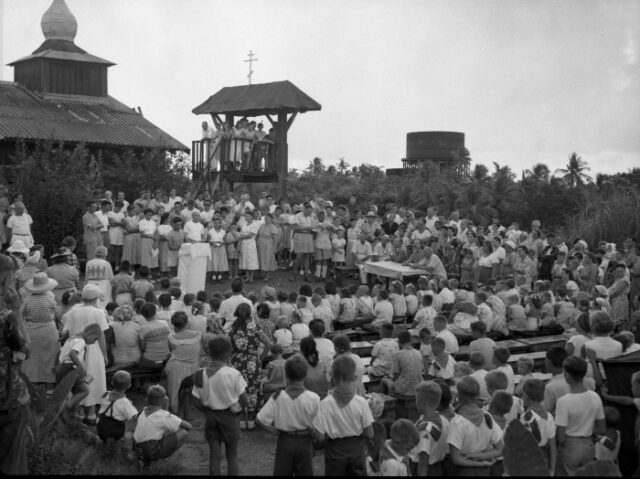
St. John’s cathedral on the island
The refugees found that Tubabao offered luscious vegetation, a coral shore, and an underdeveloped landscape that was mainly jungle and many stately coconut palms. The experience was unique and probably unforgettable for the refugees. Leaky tents were their initial accommodation, with water brought up from the river in trucks and boiled in kettles for consumption; later they built huts, a pipe to bring up the water, two churches, a school and a hospital. [9] Fitzpatrick (2019). 699. The refugees could move freely within the territory of the camp, which had no barbed wire or armed guards but a special pass from the Philippine security service was needed to go in small groups on excursions to the municipality of Guiuan, located on another island, about 15 miles distant. Moravskii observed that “The Filipinos did not misuse their power and behaved very correctly over us.” [10] cited by Dunlop (2017). 159. In order to accommodate social gatherings, a central square (‘Red Square’ – nostalgically recalling Moscow) was cleared for meetings, concerts and lectures. [11]Fitzpatrick (2019). 700. “Red Square” in Russian, known as “Krasnaya Ploshchad”, translates as “Beautiful Square”. The name stems from the old Russian word for … Continue reading The temperature on the island often soared well beyond 100° Fahrenheit, accompanied by heavy downpours of rain that would alternate and cause a constant change in temperature, severely discomforting particularly the elderly and those with health problems. There were mosquitoes as well, and other pests, and even wild animals that strayed from the surrounding jungle near the camps. [12] Dunlop (2017). 174-175. It is not surprising that many of the refugees on the island became ill, and that not a few died. In the diary entry of Olga Morozova, a well-known émigré writer during the time she lived in Tientsin (Tianjin), China, she recorded that several Russian émigrés had already gone to their final resting place:
In the Russian cemetery [on Tubabao], many observing the Russian custom, have brought Easter cakes with them, painted eggs, various delicacies and even some metal flasks containing liquor. Everywhere groups are visible now serving pannikhidas. I was at the cemetery from early morning until darkness came, leaving on the last truck. [13] Dunlop (2017). 180.
Church Life on Tubabao
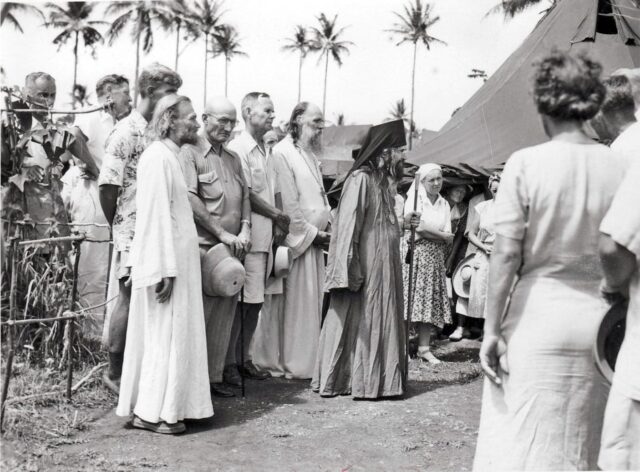
St. John with clergy
Within the first few days of their arrival on Tubabao, Russian Orthodox priests, nuns and laity set to work on organizing Church life, establishing and furnishing two tent churches on camp territory: the Church of St. Seraphim and the Church of St. Michael the Archangel. Moreover, the Philippine authorities granted them temporary use of a building that formerly had been a church for the American military.
On May 14, 1949, Archbishop John of Shanghai arrived at the camp. V. Sokoloff, one of the Shanghai exiles on Tubabao, recalls:
At the culminating point of the camp’s existence, we had three Russian Orthodox Churches. One was located outside of the camp within ten minutes of walking; we built the iconostasis and everything else required. [14] Dunlop (2017). 165.
In her diary, Olga Morozova further notes that
There is a large cathedral that stands on an elevated place, and from it there is an excellent view of the valley beneath, of the forests and sea in the distance. Near the cathedral, there is a large wooden building for three priests, and a small humble abode in the same barracks for Vladyka John, as he arrived at the camp from Shanghai. A bell tower has been constructed with real bells as well. [15] Dunlop (2017). 165-66.
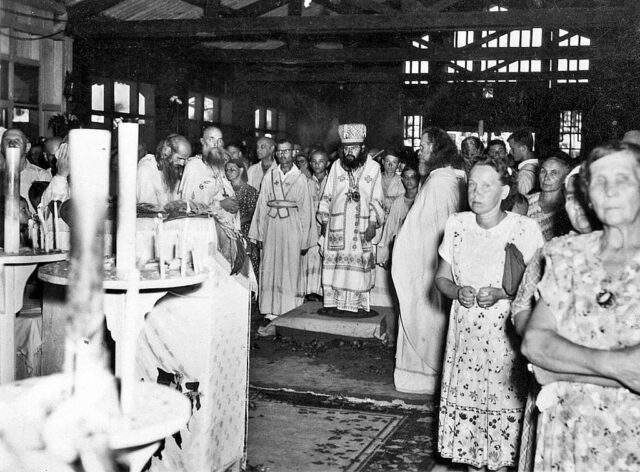
Divine liturgy in the cathedral
Despite the reality of their living conditions, the sweetest reward for living on the island was a spiritual one. Aside from the beautiful sunsets, and enjoyment of cooling off by taking a swim in the ocean, the fullness of the Church was felt by a number of émigrés as a particularly enriching experience. Quoting from the diary of A.N. Knyazev, Moravskii writes:
For Matins on the night of (Easter) Sunday, there gathered full Churches. On the first day of Pascha, in the tent of the Russian Emigrants Association, from 10:00 AM on, mutual congratulations were organized on the part of all the Orthodox residents of the camp. Aside from IRO representatives, camp superintendent, and the resettlement officer, the Philippine authorities headed by their representative Mr. Yukhino, and the local Philippine administration visited in order to offer congratulations, and the mayor of the island and village of Tubabao, Mr. Kobonze also came. The tent was decorated with flags of the IRO, the Philippine Republic as well as Russian National Flags. [16] Dunlop (2017), 208.
The camp residents both sensed and treasured the presence of Vladyka John, their intercessor and their person of fervent prayer. Everyone would know that Vladyka was walking around and blessing the camp at bedtime, and in small ways, great miracles would happen: typhoons were averted, and those who were sick were healed. Living in tents, in exhausting heat to which they were not accustomed, people would not lose courage; they would continue to maintain their Orthodox way of life.
Vladyka John was to remain in Tubabao from May 14 to July 8, 1949. Olga Morozova describes his departure in this manner:
Today Vladyka John served liturgy for the last time, after which we all bade him farewell. His departure is a great event in our lives; he united all of us and did not allow us to feel so sharply our being cut off from the world. He is all in God, all in kindness and self-sacrifice. Without him, we will indeed remain like sheep without a pastor. He is going to America and will lobby for us wherever and however he can, and he is deeply convinced that, with God’s help, although he lacks the (English) language, he will achieve for us this desired goal. [17] Dunlop (2017). 167.
Relocation Challenges
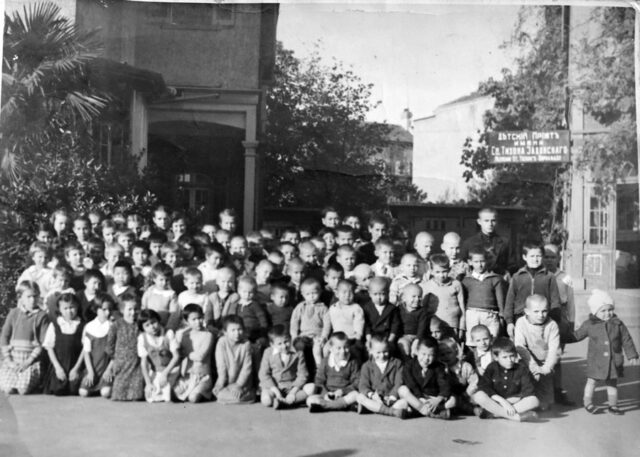
Photograph taken in San Francisco of the St. Tikhon of Zadonsk Orphanage, which arrived from Shanghai via Tubabao.
The Philippine government had originally consented to let the Russian refugees remain on the island of Tubabao for four months. Eventually, that period was, with considerable uncertainty and tension, extended many times over, for a period of roughly four years. One account from Olga Morozova says, “Today is Pascha, my second one in Tubabao! We are still here! Yesterday I went to St. Michael’s Church to have our kulich and eggs blessed.” [18] Dunlop (2017). 209. Meanwhile, Archbishop John went to the USA to make arrangements to enable the refugees to move there. After his arrival in New York, on September 5, 1949, Vladyka John left for Washington, D.C., accompanied by the Dean of Holy Trinity Seminary in Jordanville, N.Y., Nikolai N. Alexandrov, who served as his English translator. Archpriest Peter Perekrestov, biographer of Saint John, writes,
Beginning September 6, Archbishop John began to visit the senators and government offices, and also to meet with journalists. Archbishop John and Prof. Alexandrov were invited to a session of the Senate Commission in order to lay out the essence of their case; this session took place on September 16. [19] Dunlop (2017). 220.
After a hard-fought battle of seeking approval from the United States authorities, on June 16, 1950, President Harry S. Truman signed the Bill which amended the Displaced Persons Act of 1948. [20] Dunlop (2017). 235. As a result, a large part of the camp on Tubabao, about 3,000 people, moved to the USA, and the remainder of the refugees were accepted by Australia.
Filipino Orthodoxy: Past and Present
It also happened that White Russians who were living in the capital, Manila, in the 1930’s had also established a Russian Orthodox Church. [21] Toro, D. K. “The First Russian-Greek Church in the Philippines.” Sunday Tribune Magazine, 1939. n.d., 14. The Manila parish was led by its rector, Archpriest Michael Erohin, [22] Священник Михаил Ерохин, Священник Михаил Ерохин accessed June, 2025. who in 1939 told the Philippines Sunday Tribune Magazine, “The Church is not receiving help from abroad. The generous aid of local White Russians and some Filipinos is largely responsible for the continuation of the Church activities.” [23] Toro (1939). 14. Fr. Michael passed away soon afterwards and by the end of World War II there is no trace of the Manila community.
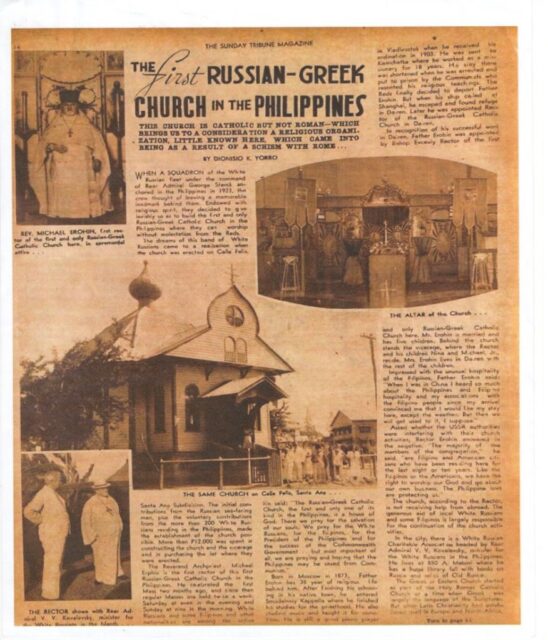
In 2009, a group of diaspora Russians who were residing in the USA and in Australia, known as the ‘Tubabaotsy,’ celebrated in Sydney the 50th anniversary of their stay in the Tubabao Camp. Some attended celebrations in the Philippines, where the country’s generosity to the Russian refugees was remembered as part of the legacy of the then ruling President, Elpidio Quirino. [24] Fitzpatrick (2019). 711.
Then, in 2016, a few ‘Tubabaotsy’ participated in the Congress of Russian Americans exhibit ‘Tiempo Russo Tubabao Island,’ named after the last boat that took Tubabao refugees to the U.S. and dedicated to St. John Maximovitch. The exhibit was prepared and presented by the Congress of Russian Americans with the support of the Philippine and Russian Consulates. [25] “65th Year Commemorating of Tubabao.” Congress of Russian Americans. October 27, 2016. https://russian-americans.org/19509-2. accessed May, 2025.
In January, 2013, the Russian Orthodox Church Outside of Russia (ROCOR) blessed the restarting of the mission in the Philippines. Hieromonk Philip, ROCOR Dean of the Mission in the Philippines, identified the exact location of the church where Saint John lived in exile in Tubabao. Thereafter, a parish was established in Davao del Sur (located some 300 miles from Tubabao) in honor of St. John of Shanghai and San Francisco.
On August 21, 2015, priests of the Moscow Patriarchate baptized 239 Philippine people at the St. John the Baptist Orthodox Church (Moscow Patriarchate) in the Ladol district of Alabel, Sarangani Province in the Philippines. [26] “Mass Baptism in the Philippines.” OrthoChristian.com. 2015. https://orthochristian.com/81728.html. accessed May, 2025.
There have been efforts to establish a special day to commemorate Saint John Maximovitch in the province of Eastern Samar which includes the island of Tubabao. On August 29, 2019, on the initiative of Hieromonk Philip, according to a report on the site of the Philippine Mission of the ROCOR, the Sangguniang Bayan (Legislative Council) of Guiuan, the municipality to which Tubabao Island belongs, approved a petition from local Orthodox representatives to officially mark July 2 as ‘St. John of Shanghai and San Francisco Day.’ [27] “Filipino Municipality Establishes St. John (Maximovitch) Day.” OrthoChristian.com. 2019. Filipino municipality establishes St. John (Maximovitch) Day / OrthoChristian.Com accessed May, 2025. Hieromonk Philip continues to lobby members of the Philippines House of Representatives to pass a law which would establish the local holiday of St. John as a national holiday.
In July, 2023, with the blessing of the Synod of Bishops of the ROCOR, a mission parish was established in Quezon City, Philippines, in honor of the Synaxis of the Three Hierarchs: Saint Basil the Great, Saint Gregory the Theologian, and Saint John Chrysostom.
Conclusion
The Philippines continues to receive great spiritual blessings from the brief mission of Saint John Maximovitch to the 5,000 Russian exiles on the island of Tubabao. Saint John Maximovitch stayed for only a very short time in the Philippines, However, the influence of the Saint in the Philippines is immeasurable and provides a daily inspiration for the ever-growing community of Philippine Orthodox Christians, especially for those that have allegiance to the ROCOR Synod of Bishops of which St. John Maximovitch was a part.
Biographical Note
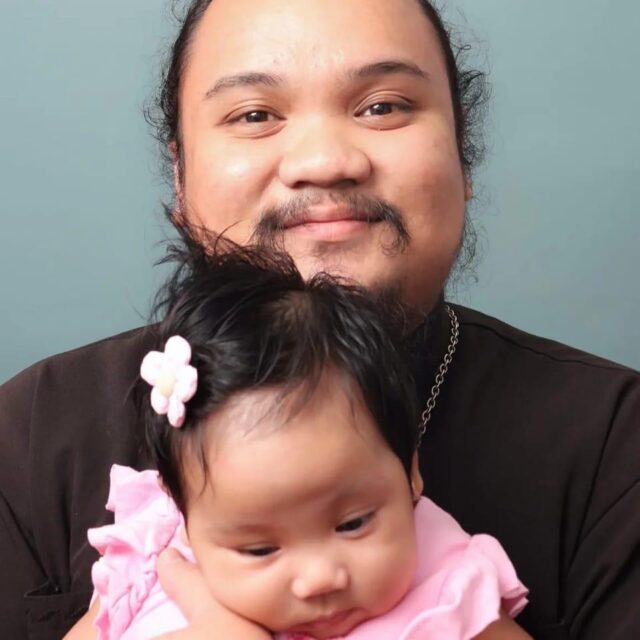 Ordained to the priesthood by His Grace, Bishop Luke of Syracuse, in 2022, Fr. Lawrence Cunningham is an assistant priest of the ROCOR Mission in the Philippines, serving at the Three Holy Hierarchs Orthodox Church in Quezon City, Philippines. In June of 2025 Fr. Lawrence graduated from Holy Trinity Orthodox Seminary, Jordanville, NY, where he was awarded the degree of Master of Divinity.
Ordained to the priesthood by His Grace, Bishop Luke of Syracuse, in 2022, Fr. Lawrence Cunningham is an assistant priest of the ROCOR Mission in the Philippines, serving at the Three Holy Hierarchs Orthodox Church in Quezon City, Philippines. In June of 2025 Fr. Lawrence graduated from Holy Trinity Orthodox Seminary, Jordanville, NY, where he was awarded the degree of Master of Divinity.
References
| ↵1 | ‘White Russians’ refers to people who fought against the ‘Reds’ in the Soviet Union after the Bolshevik Revolution. |
|---|---|
| ↵2 | IRO was a United Nations agency focused on addressing the refugee crisis following World War II. Its main functions included administering camps for displaced persons, helping them resettle, and providing services like vocational training and tracing lost relatives. The IRO also took over the work of the Intergovernmental Committee on Refugees, which previously had been responsible for the legal protection and resettlement of refugees. |
| ↵3 | Fitzpatrick, Sheila. 2019. “Russians in the Jungle: Tubabao as a Way Station for Refugees from China to Australia, 1949.” History Australia 16 (4): 695–713. Russians in the jungle: Tubabao as a way station for refugees from China to Australia, 1949: History Australia: Vol 16 , No 4 – Get Access accessed May, 2025. |
| ↵4 | Fitzpatrick (2019). 698. |
| ↵5 | Dunlop, John B. 2017. Exodus: St John Maximovitch Leads His Flock out of Shanghai. (2017, SVS Press). 145. |
| ↵6 | Nikolai Moravskii was born in Shanghai in 1923 into a family of Russian émigrés. In 1949 he was evacuated to the Philippines. |
| ↵7 | Cited by Dunlop (2017). 159. |
| ↵8 | Fitzpatrick (2019). 701. |
| ↵9 | Fitzpatrick (2019). 699. |
| ↵10 | cited by Dunlop (2017). 159. |
| ↵11 | Fitzpatrick (2019). 700. “Red Square” in Russian, known as “Krasnaya Ploshchad”, translates as “Beautiful Square”. The name stems from the old Russian word for ‘beautiful’ and ‘red’ being the same. Its use here did not imply communist sympathies. |
| ↵12 | Dunlop (2017). 174-175. |
| ↵13 | Dunlop (2017). 180. |
| ↵14 | Dunlop (2017). 165. |
| ↵15 | Dunlop (2017). 165-66. |
| ↵16 | Dunlop (2017), 208. |
| ↵17 | Dunlop (2017). 167. |
| ↵18 | Dunlop (2017). 209. |
| ↵19 | Dunlop (2017). 220. |
| ↵20 | Dunlop (2017). 235. |
| ↵21 | Toro, D. K. “The First Russian-Greek Church in the Philippines.” Sunday Tribune Magazine, 1939. n.d., 14. |
| ↵22 | Священник Михаил Ерохин, Священник Михаил Ерохин accessed June, 2025. |
| ↵23 | Toro (1939). 14. |
| ↵24 | Fitzpatrick (2019). 711. |
| ↵25 | “65th Year Commemorating of Tubabao.” Congress of Russian Americans. October 27, 2016. https://russian-americans.org/19509-2. accessed May, 2025. |
| ↵26 | “Mass Baptism in the Philippines.” OrthoChristian.com. 2015. https://orthochristian.com/81728.html. accessed May, 2025. |
| ↵27 | “Filipino Municipality Establishes St. John (Maximovitch) Day.” OrthoChristian.com. 2019. Filipino municipality establishes St. John (Maximovitch) Day / OrthoChristian.Com accessed May, 2025. |

